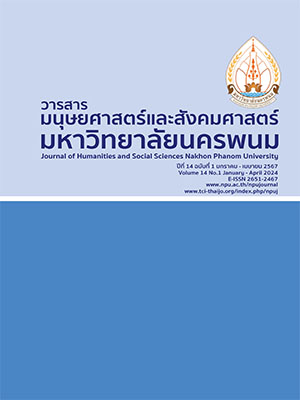พิพิธภัณฑ์ประธานโฮจิมินห์ จังหวัดนครพนม: การสร้างพื้นที่แห่งความทรงจำร่วม ระหว่างไทย-เวียดนาม หลังยุคสงครามเย็น
Main Article Content
บทคัดย่อ
การวิจัยครั้งนี้มีวัตถุประสงค์เพื่อศึกษาบริบทการจัดตั้งพิพิธภัณฑ์ และความทรงจำร่วมในพิพิธภัณฑ์ประธานโฮจิมินห์ อำเภอเมือง ตำบลหนองญาติ จังหวัดนครพนม เป็นการวิจัยเชิงคุณภาพโดยวิธีวิทยาทางมานุษยวิทยาและประวัติศาสตร์ เก็บรวบรวมข้อมูลจากเอกสารชั้นต้นและชั้นรองในภาษาไทย ภาษาเวียดนาม และภาษาอังกฤษการสัมภาษณ์ผู้ที่มีส่วนเกี่ยวข้องจำนวน 20 คน โดยการเลือกแบบเจาะจง ประกอบด้วย ชาวไทยเชื้อสายเวียดนามปราชญ์ชาวบ้าน ตัวแทนสมาคมไทยเวียดนามจังหวัดนครพนม ผู้แทนหน่วยงานภาครัฐ นักการเมือง ผู้เชี่ยวชาญ ด้านมานุษยวิทยา และผู้เชี่ยวชาญด้านประวัติศาสตร์ ผลการวิจัยพบว่า 1) พิพิธภัณฑ์ประธานโฮจิมินห์ จังหวัดนครพนม ได้รับการจัดตั้งขึ้นเพื่อเป็นพื้นที่ความทรงจำร่วมและกลไกทางการทูตวัฒนธรรมและประวัติศาสตร์ระหว่างไทย-เวียดนามภายหลังยุคสงครามเย็น 2) ความทรงจำที่ถูกเลือกสรรในพิพิธภัณฑ์มีลักษณะของความทรงจำฉบับทางการ สอดคล้องกับประวัติศาสตร์ของรัฐ เกี่ยวข้องกับการเคลื่อนไหวของประธานโฮจิมินห์ และความสัมพันธ์ระหว่างไทย-เวียดนาม 3) ความทรงจำที่ถูกลืมในพิพิธภัณฑ์ประธานโฮจิมินห์ เช่น การนับถือโฮจิมินห์ในฐานะเทพเจ้าที่ยังมีชีวิตในช่วงสงครามเวียดนาม และเรื่องราวทางประวัติศาสตร์ของชาวไทยเชื้อสายเวียดนามในนครพนม ผลการวิจัยเป็นข้อมูลให้หน่วยงาน ที่เกี่ยวข้องใช้ปรับปรุงรูปแบบการจัดแสดงและเนื้อหาในพิพิธภัณฑ์ประธานโฮจิมินห์ และการสร้างความเชื่อมโยงทางการท่องเที่ยวระหว่างไทย-เวียดนามตามเส้นทางตามรอยโฮจิมินห์ในเมืองไทย
Article Details

อนุญาตภายใต้เงื่อนไข Creative Commons Attribution-NonCommercial-NoDerivatives 4.0 International License.
เอกสารอ้างอิง
Akbaş, M. and Kelekci, Ö. (2021). From factory to museum: The obliteration of the history of resistance. In Adele Chynoweth (ed.). Museums and the Working Class. (111-123). New York : Routledge.
Alisa, G. (2021). The Universal Museum And International Relations: Obstacles To The Full Realization Of Museums In Cultural Diplomacy (Unpublished bachelor’s thesis). Salem State University, Massachusetts, United States of Amarica.
An, V. (1977). Sơ lược về phong trào cứu nước của Việt kiều ở Thái [Summary of the National Salvation Movement of Overseas Vietnamese in Thailand]. Unpublished manuscript.
Anderson, B. (1998). The Spectre of Comparisons: Nationalism, Southeast Asia, and the World. London : Verso.
Bethwaite, J. (2022). Fine arts and international relations.In Sirke Mäkinen and Tuomas Forsberg (eds.). Russia’s Cultural Statecraft. (50-17). New York : Routledge.
Bình, V. (2020, 22nd December). A Thai of Vietnamese Origin. Interview.
Boonchawalit, J. (2020, 28th April). The manager of Ho Chi Minh memorial site in Nakhon Phanom. Interview.
Bunmi, B. (2004). Thīralư̄k nai phithī pœ̄t mūbān mittraphāp Thai - Wīatnām [The Handbook for the Opening Ceremony of the Thai-Vietnamese Friendship Village]. Unpublished manuscript.
Burke, F. (2020). Exhibiting activism at the Palestinian Museum. Critical Military Studies. 6(3-4),360-375. https://doi.org/10.1080/23337486.2020.1745473
Burusphat, K. (1988). Yūan ʻopphayop [Vietnamese Refugee]. Bangkok : Duangkamol.
Đài tiếng noi Việt Nam. (2020). Tôn vinh Chủ tịch Hồ Chí Minh chính là tôn vinh dân tộc Việt Nam [Honoring President Ho Chi Minh is honoring the Vietnamese people]. Retrieved March 2024, from https://vov.gov.vn/ton-vinh-chu-tich-ho-chi-minh-chinh-la-ton-vinh-dan-toc-viet-nam-dtnew-150862
Florez, E and Eccles, K. (2022). Museums as Platforms of Resistance: The Use of Technology in Conflict Memory, Transitional Justice and Peacebuilding. Museum International. 74(3-4),82-93. https://doi. org/10.1080/13500775.2022.2234196
Grincheva, N. (2019). Beyond State versus Non-state Dichotomy: The State Hermitage Museum as a Russian Diplomacy ‘Hybrid’. The Hague Journal of Diplomacy. 14(3),225-249. DOI:10.1163/1871191X-14401025
Halbwachs, M. (1992). On Collective Memory. Chicago : University of Chicago Press.
Ho Chi Minh Museum. (2019). Ho Chi Minh Memorial in Nakhon Phanom. Retrieved December 2023, from https://baotanghochiminh.vn/khu-tuong-niem-chu-tich-ho-chi-minh-tai-lang-nachok-ban-may-tinh-nakhon-phanom-thai-lan.htm
International Council of Museum. (2022). Museum Definition. Retrieved December 2023, from https:// icom.museum/en/resources/standards-guidelines/museum-definition/
Jaitiang, T. (2001). Lung hō kap yutthasāt kān kū chāt thī Nakhō̜n Phanom [Uncle Ho and His Liberating Strategy at Nakhon Phanom]. Unpublished manuscript.
Japanese Village. (2018). Background information on the Japanese Village. Retrieved December 2023, from https://www.japanesevillage.org/japanese-village/
Khamwan, S. (2020). Anusorn sathān Prathan hō čhi min čhangwat Nakornpanom : kānsāng phư̄nthī hǣng khwām song čhō̜ kīaokap hō čhi min nai chumchon chāo wīatnām phlatthin nai mư̄ang thai [Ho Chi Minh Memorial in Nakhon Phanom: A Construction of Ho Chi Minh's Collecttive Memory for Vietnamese Diaspora Community in Thailand]. In Srikham, W. (Ed.), In Proceedings of Thailand'’ 2nd Annual Conference on Anthropology and Sociology (pp. 285-302). Ubon Rachathani : Ubon Rachathani University.
Khamwan, S. (2022). Phāplak Thai nai sư̄ Wīatnām : kō̜ranī khwāmkhatyǣng Thai - Lāo nai chūang plāi thotsawat nưngphankāorō̜ipǣ [The Image of Thailand in Vietnamese Media: The study of Thai Land and Lao Conflict in the late 1980s]. In Her Royal Highness Princess Maha Chakri Sirindhorn (Ed.), In Proceedings of Thailand and Indochina during the ASEAN Community period (pp. 289-304). Bangkok : NRCT.
Mariano, R. and Vårheim, A. (2022), Libraries, museums and cultural centers in foreign policy and cultural diplomacy: a scoping review. Journal of Documentation. 78(3),651-672. https://doi.org/10.1108/JD-05-2021-0103
Murashima, E. (2012). Kamnerd phak khō̜mmionit Siam ( phō̜ . sō̜.sō̜ngphansīrō̜ičhetsipsām - 2479) [The Birth of the Siam Communist Party (1930-1936)]. Bangkok : Matichon.
Muscat, M. (2020). The Art of Diplomacy: Museums and Soft Power. Retrieved December 2023, from https://www.wathi.org/the-art-of-diplomacy-museums-and-soft-power-e-international-relations-november-2020/
Nantachukra, A. (2001). Mūbān nā čhō̜k : ʻadīt læ patčhuban [Najok Village: Past and Present]. Unpublished manuscript.
Nora, P. (1995). Realms of Memory : Rethinking the French Past. New York : Columbia University Press.
Ongphimai, T., Boonwanna, T. and Boonaree, C. (2019). Phāp khō̜ng hō čhi min nai Siam chūang pī khō̜ . sō̜ .nưngphankāorō̜iyīsippǣt nưngphankāorō̜isāmsip mō̜ng phān nangsư̄ “Bác Hồ ở Thái Lan (lung hō nai Prathed thai) [Images of Ho Chi Minh in Siam from 1928 to 1930 through Bác Hồ ở Thái Lan (Ho Chi Minh in Thailand)]. In Chanthao, R. (Ed.), In Proceeding of IC - Hu So 2019 Religion and Development in Plurality Society (pp. 1615-1637). Khon Kean : Khon Kean University.
Paitoon, N. (2021, 21st January). A Former Thai Official. Interview.
Priewe, S. (2021). Museum Diplomacy: Parsing the Global Engagement of Museums. Los Angeles : Figueroa Press.
Sripana, T. (2005). Hē wī yot kīao : nai Prathed thai kap khwāmsamphan thai - wīatnām [Viet Kieu in Thailand in Thai-Vietnamese relationship]. Bangkok : Sriboon Computer and Publishing.
Sieg, K. (2021). Decolonizing German and European History at the Museum. Michigan : University of Michigan Press.
The Princess Maha Chakri Sirindhorn Anthropology Centre. (2021). Praphēt phiphitthaphan tām kānčhat sadǣng [Museum Catagories]. Retrieved December 2023 from, https://db.sac.or.th/museum/
Thippimol, O. (2022). Phiphitthaphan hǣng kān thō̜rayot khō̜ng phak khō̜mmiunit ʻin dōnī sīa [Museum of Betrayal of the Indonesian Communist Party]. In Thiamsoon Sirisrisak (ed). Phiphitthaphan læ mō̜radok thāng watthanatham [Museums and Cultural Heritage]. (38-59). Bangkok : Thammasat University.
Tidy, J. and Turner, J. (2020). The Intimate International Relations of Museums: a Method. Millennium. 48(2), 117-142. https://doi.org/10.1177/030582981988913
Wichayasut, C. (2020, 22nd December). A Politician. Interview.


